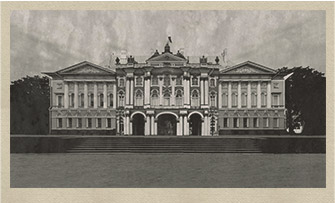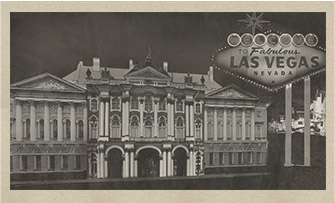| |
 |
|
 |
We don’t usually publicise
our Family’s history, but following several erroneous
reports of late in the local media, we feel obliged to set a
few facts straight. After reading, please forget everything
contained here-under:
|

 |
Built in 1865, this magnificent St
Petersburg mansion was the family home of Piotr “Pierre”
Kirillovich Buzukhov. Leo Tolstoy based a leading character
in War and Peace on Pierre, changing the surname to Bezukhov
for obvious reasons, and the Mansion was mentioned in the
pages of that epic novel. While it’s true Tolstoy did employ
a certain dramatic license in fashioning his Pierre, certain
details from the novel were true to life: the real Pierre
did have a passion for the roulette wheel and did kill his
first wife’s lover in a duel; and he did flee to Moscow to
become a Freemason, specifically involved with the secret
society known as the Illuminati.
Like Tolstoy’s creation, the real
Pierre did eventually come to his senses and find peace with
a woman called Natasha, returning to live in the family
Mansion in St Petersburg. He dedicated his later years to
music, writing several operas with libretti based on
Benjamin Franklin’s Almanacs of Poor Richard Saunders, and
gave concert performances of them in the lavish ballroom,
playing the Armonica, invented by Franklin and sometimes
referred to as ‘The Voice of the Angels’.
Pierre also attempted to
rehabilitate what was left of the Family’s estate. It had
suffered from a certain mismanagement and been in decline
since the liberation of the serfs. To do this, he turned
part of his Mansion into a gambling hall, distinguished by
two things: a high stakes version of the fashionable parlour
game Gossamer; and a variation on the famous Russian card
game Podkidnoy Durak (‘Fool who throws in the towel’). This
game is famous for its insistence that the Loser, the fool
who throws in the towel, must wear two cards, a pair of
sixes, on his epaulets, as an emblem of his foolishness.
Pierre embroidered the traditional game by combining it with
the finer points of Russian Roulette.
All went well in the Mansion until
1905, when disaster struck in the form of the first of
Russia’s revolutions. (See Battleship Potemkin and the
opening chapters of Doctor Zhivago.) The ageing Pierre
narrowly avoided assassination in Odessa and was forced to
flee Russia with his son and heir, Evgeny. How Pierre and
Evgeny and their coterie of Russians ended up in the middle
of the Mojave Desert is a bit of a mystery…
…but they did.
|

 |
What was certain was that
Buzukhovs used part of their family fortune, magnificent
diamonds smuggled out of Russia in a red scarf (concealed in
a private part of a certain body), to buy land in the
railway town of Las Vegas, purchased from a certain copper
magnate named William Clark. They built a new Mansion, which
was, in fact, a replica of the Buzukhov family Mansion in St
Petersburg, except more colourful. (By 1919, the Bolsheviks
had turned the original into a stolovaya, a canteen-like
restaurant serving utilitarian meals to Soviet workers – a
far cry from the Buzukhov love of caviar and champagne.)
Following the death of his father,
Evgeny honoured the family tradition by giving the Vegas
Mansion a double identity: he made it Las Vegas’s finest
(and certainly its most secretive) illegal casino. The
Mansion thrived, especially after the arrival of the gaming
sensation Le Multicolore, an alternative divertissement to
roulette invented in 1919 by the French President Raymond
Poincaire, and brought to America by a Frenchman named
Charles Le Savant. Many believe Charles was connected to the
local landmark Frenchman’s Mountain, but his descendants
will tell you this is questionable, given Frenchman’s was
named after a Belgian.
Evgeny called his mansion/casino:
Nocturne. He used the proceeds of his divertissement to
track down and bring to Las Vegas all the surviving
instruments of his grandfather’s magnificent musical
collection, including the Armonica and the Glass Harp.
|
 |
The Falzone family, originally
from Florence, were the proprietors of one of Europe’s
largest and most renowned entertainments, The Falzone Family
Circus, celebrated for its clowns and animals and a
combination of both, The Clanimals. In 1906, they chanced to
be presenting their magnificent spectacle in San Francisco,
opening on April 14, just four days before the devastating
earthquake that destroyed 80% of the City by the Bay.
For the Falzone family, the
natural disaster was catastrophic. Many of their acrobats,
trainers and backstage crew died in the initial quake; and
their magnificent Big Top burnt to the ground in the
subsequent fire. The majority of the animals and, indeed,
all the Clanimals, fell victim to the flames and the trauma,
many of them dying in their cages or caravans.
In the weeks following the
catastrophe, the surviving family members gathered at the
Embarcadero and, pooling their resources and joining forces
with two Chinese survivors (one a mysterious monk, the other
a restaurateur), bartered a voyage South on the clipper ship
Forever which, with favourable winds, took them swiftly to
the Mexican port of Veracruz.
For the next 13 years the Falzones
wandered the South-West as gypsy travellers, performing (and
making noodles) wherever they could: in dancehalls, saloons,
and on bandstands in parks – even in family homes, where
they would play improvised musical instruments, juggle with
their feet and do the closest of close magic on request. On
special occasions they might even summon the spirits of the
Clanimals, in a strange, jaggery dance that found
celebration and optimism in what was essentially a tale of
woe.
In 1921, by chance, the Falzone
family staggered into the railroad city of Las Vegas and,
when passing a magnificent Mansion, heard a strange,
mesmeric sound: “The voice of the angels”. As if under a
spell, the beautiful family heir, Fiorenza, knocked on the
Mansion’s door and…
The man who opened the door on
that fateful day was Evgeny Buzukhov and…
The rest is Las Vegas history. The
Buzukhov-Falzones have lived in this Mansion for over 90
years, performing certain rituals for the entertainment of
visitors who come to dine, socialise or trade fortunes on
the capricious wheel of Le Multicolore. The also use the
Mansion as a refuge for Unusualists – anyone who, like the
original family members, is distinguished by a colourful
past or hobby and needs a place to prosper and prepare. |
|
|
|